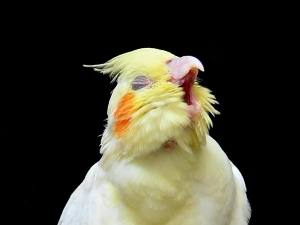
One twitch at your cockatiels leg may not alarm you, but if your cockatiels leg twitches constantly then you may want to look into it
This article looks into why your cockatiels leg may be twitching
Table of Contents
Cockatiel leg twitching:
Any change in behavior in your bird means that something is going on with the little fella.
A twitching in your bird’s leg means that the bird is suffering a seizure.
This is what you need to know about this:
Seizures in your cockatiel:
Seizures can cause a slight, or a drastic, change in the demeanor of your bird.
It can cause your bird’s leg to twitch uncontrollably, or, it can cause your bird to have a violent muscle spasm.
The length of the seizure is not always the same. It can span a minute or two, or, it could last for a few seconds before it’s gone.
Seizing can happen in cockatiels, and, in a variety of other types of birds. The signs are similar regardless of the type of bird.
Other signs of a seizure:
Not only will the seizure cause your cockatiel to twitch its leg, this episode can also cause your bird to stagger, jerk uncontrollably, vocalize uncontrollably, defecate, fall to the bottom of the cage, lose its ability to coordinate its muscle movements, become exhausted, confused, agitated and restless.
Causes of seizures:
Seizures in your birds can be triggered by a variety of things.
These triggers can cause the bird to develop seizures because they trigger a spontaneous electrical charge in the bird’s nervous system which causes the seizure.
This incident can be caused by a nutritional deficiency, environmental stressor, the ingestion of a toxin, physical injury to the bird’s head (which could lead to injury to the bird’s brain), infectious diseases, and sometimes, the reason behind the seizure may simply be unknown.
What to do:
Your seizing cockatiel needs to be seen by a vet. Keep the bird comfortable until you can get the bird to the vet.
The bird can injure itself while seizing so keeping the bird safe when you notice the seizing is a must.
The bird will fall when seizing so lowering the perches in the bird’s cage, and adding padding to the bottom of the bird’s cage, is recommended.
Placing the bird’s cage in a quiet, dimly lit, and warm room will also help the bird get comfortable and feel safer.
Feeding the bird foods that it will eat that are nutritious and easily digestible is also recommended.
Foods such as Nutri-An cakes and greens are recommended.
The bird may drown if it falls into a deep dish of water so only give the bird water in a shallow dish.
At the vet:
The vet will examine the bird and run tests on the bird to get a diagnosis. Giving the vet the history of the bird will also help.
The treatment that the vet gives the bird will be chosen based on the underlying cause of the seizures.
Treatments can be anything from medications to remove toxins, antifungals, antibiotics, anticonvulsants, a short course of steroids, or even acupuncture in some cases. Your vet will advise.
If you enjoyed this article then you may also be interested in other bird related articles. Here are some articles that you may be interested in: Stress Seizures In Birds, Bird Died After Bath, Budgie Twitching Leg, Canary Twitching Head, Why Does My Cockatiel Love My Feet?, Why Does My Cockatiel Sing To My Feet?, How Do I Know If My Budgies Beak Is Too Long?, Why Is My Budgies Head Bleeding?, What To Do If Budgie Beak Is Too Long?

